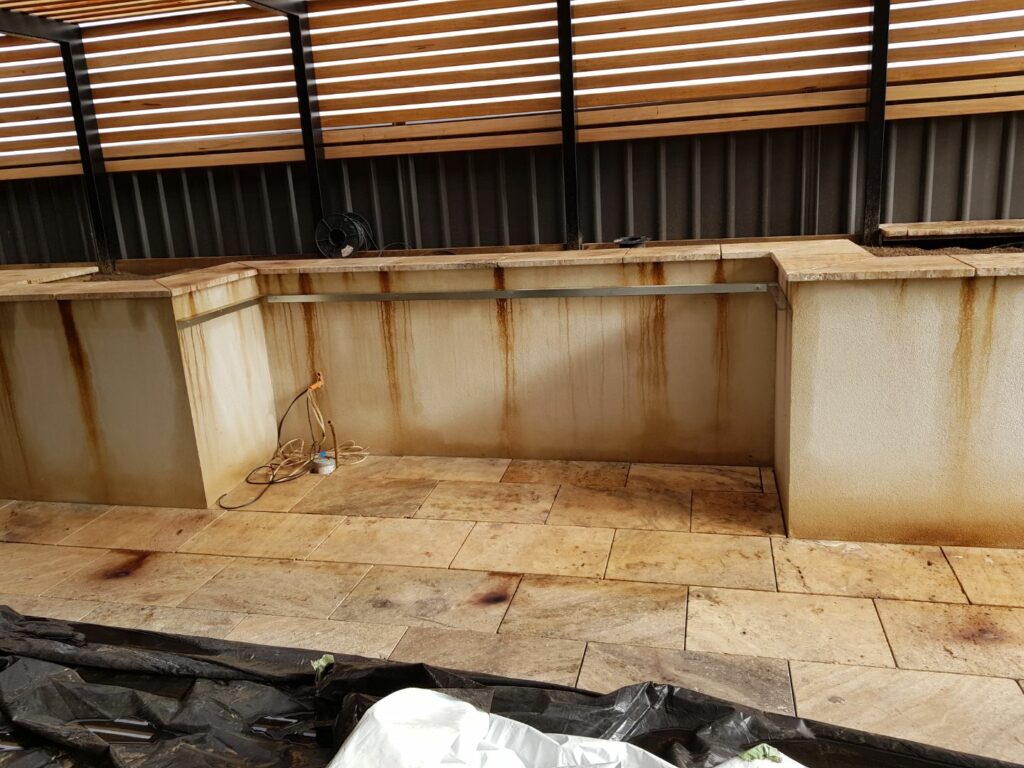How to Minimise Tannin Leaching
Timber decking and cladding can discolour surrounding surfaces due to timber leaching and tannin bleeding.
Tannins are one of the many natural extractives present in timber. They’re water-soluble and are released from the timber upon getting wet. This process is referred to as timber leaching or tannin bleeding which can stain surfaces like concrete, render and pavers, making the timber surround unsightly.

Example of tannin leaching
All hardwoods contain tannins, however, some species are more prone to timber leaching than others. For instance, timber like Merbau and Blackbutt are more susceptible to bleeding tannin than others like Ironbark, Spotted Gum and Cumaru. Tannin stains are brownish in colour, but Merbau produces a red-brown stain that can be very obvious and time-consuming to remove. Timber structures exposed to the elements, such as timber decks are commonly affected by tannin leaching. If your deck is surrounded by concrete, pavers, or render, then you should consider choosing a low-tannin leaching species to avoid staining.
Although tannin tends to leach from timber only for a short time and is generally not a long-term concern, it should not be underestimated. High extractive timber, even when painted, can still show signs of leaching and staining. However, the good news is there are multiple ways to minimise tannin leaching.
Use Tannin Blocking Primer or Tannin Removers
For painted timber, high-quality tannin blocking primers are available in the market to reduce timber leaching. These primers should be used on the timber before applying the topcoat. Fully coated decking boards do not allow moisture to penetrate, thereby limiting tannin release on surrounding surfaces. Coating timber not only helps lock extractives but also keeps them in a pristine condition for years to come.
For oiled timber, Tannin remover and deck cleaning products can be used repeatedly to wash out tannin stains. Once the timber is washed with the right cleaning agents and finished with a protective coat, it’ll automatically reduce leaching.
Pre-Coat the Timber to Maintain Decking
It is very important to maintain the timber coating on decking. Timber pre-coats can eventually break down from UV exposure and wear which can let the moisture back in, allowing the tannins to bleed out. Receiving timber that is factory-coated with Intergrain Universal Oil from Bowens, can help minimise the timber leaching process.
Alternatively, you can leave the high tannin timber decks raw over the winter season to leach out. You can do this if your deck is surrounded by a garden or lawn where leaching can run into the soil without causing any noticeable issues. Once the tannin leaching is reduced you can clean the deck and apply a finish coat to restrict further bleeding.
It is ideal to choose kiln-dried timber for outdoor construction if you’re concerned about leaching. Kiln-dried timber ensures stability and minimises tannin bleeding compared to unseasoned timber. Ultimately prevention is better than cure. So best practice to minimise leaching is to pre-coat and maintain coatings, apply tannin removers or blockers, or select low-tannin timber species in certain designs.
For more information on timber decking and cladding maintenance, get in touch with the Bowens customer service team today.
For more information on Bowens Pre-coated Timber service.










